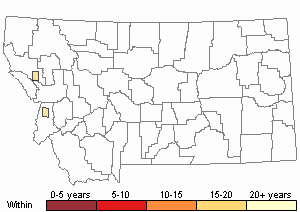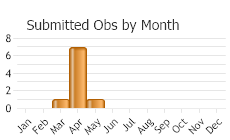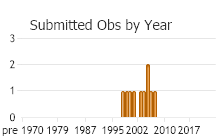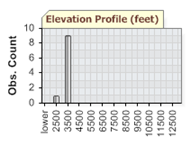View in other NatureServe Network Field Guides
NatureServe
Montana
Utah
Wyoming
Idaho
Wisconsin
British Columbia
South Carolina
Yukon
California
New York
California Marble - Euchloe hyantis
General Description
Recent genetic research (Back et al. 2011) indicates that Euchloe hyantis (California Marble) and E. lotta (Desert Marble) should be considered subspecies of a single species, E. hyantis, thus reverting back to their earlier treatment as E. h. hyantis and E. h. lotta (Opler 1968; Scott 1986). The subspecies occurring in Montana is, once again, E. h. lotta. The following account includes some information pertaining to both subspecies.
[From Ferris and Brown 1981; Scott 1986; Opler and Wright 1999; Glassberg 2001; Pyle 2002] Forewing 1.6-2.1 cm. Uppersurface white with black pattern on forewing tip, black forewing bar lacking scattered white scales, costal margin well-checkered with black; undersurface of hindwing with dark green marbling, veins generally not noticeably yellower than marbling, intervening white areas with pearly iridescence.
Phenology
One flight: April to May most areas, mid-March to early May in the south, June in the mountains (Scott 1986). March to April in southern deserts, April to June farther north, June to July at higher elevations (Glassberg 2001). March to June in the Rocky Mountain states (Ferris and Brown 1981), late March to late June in Oregon and Washington (Pyle 2002; Warren 2005), April and May in British Columbia (Guppy and Shepard 2001).
Diagnostic Characteristics
Best determined by combination of uppersurface white, black forewing bar lacking scattered white scales; undersurface of hindwing with dark green marbling, intervening white areas with pearly iridescence.
Species Range
Montana Range
Range Descriptions

 Native
Native
Range Comments
Southern British Columbia south throughout the intermountain west to northern Baja California, east to western Montana, western Wyoming, western Colorado, western New Mexico, northern Mexico (Scott 1986; Opler and Wright 1999; Glassberg 2001); to at least 2286 m elevation in Colorado (Brown 1957), to at least 2743 m elevation in central California (Shapiro 1977), 76 m to 2652 m elevation in Oregon (Warren 2005). In Montana, reported from most counties in the western 1/4 of the state and across the south as far east as Big Horn County (Kohler 1980; Stanford and Opler 1993; FLMNH Lepidopterists' Society database), to at least 1662 m elevation. Uncommon to locally common (Glassberg 2001).
Observations in Montana Natural Heritage Program Database
Number of Observations: 10
(Click on the following maps and charts to see full sized version)
Map Help and Descriptions
Relative Density

Recency



 (Observations spanning multiple months or years are excluded from time charts)
(Observations spanning multiple months or years are excluded from time charts)
Migration
Non-migratory.
Habitat
E. h. hyantis: Open hills and forested slopes, chaparral, granitic moraines, serpentine outcrops, sunny cliffs; E. h. lotta: arid lands, desert foothills, sagebrush steppe, pinyon-juniper woodland (Scott 1986; Opler and Wright 1999; Glassberg 2001). Habitat in Montana (for E. h. lotta) not described but probably similar; in the Greater Yellowstone Ecosystem, reported in rocky canyons, ridges, cutbacks (Debinski and Pritchard 2002).
Food Habits
Larval food plants are native and introduced mustards, including Arabis (multiple species), Caulanthus (multiple species), Descurainia, Halimolobos, Isatis, Lepidium, Sisymbrium, Stanleya, Streptanthus (multiple species), Streptanthella, and Thelypodium (Opler 1974; Ferris and Brown 1981; Scott 1986; Graves and Shapiro 2003; Warren 2005). Adults feed on flower nectar, including Amsinckia, Phlox, and many species of mustards (James and Nunnallee 2011).
Reproductive Characteristics
Females lay eggs singly (50 eggs by one female reported), usually on host plant buds, flowers, stems, leaves (Opler 1974; Scott 1986; James and Nunnallee 2011). Eggs hatch in about 4-5 days (depending on temperature), develop rapidly to L5 instar and pupate in about 17-18 days post egg-hatch usually on host plant stem; pupae overwinter, adults eclose (emerge from pupae) in spring. Larvae solitary, feed on all parts of host plant, build no nest (Scott 1979; James and Nunnallee 2011). Males patrol throughout the day on hilltops, sagebrush flats, in gullies, sometimes near larval host plants, in search of females (Scott 1975b, 1986: Warren 2005; James and Nunnallee 2011).
Stewardship Responsibility
References
- Literature Cited AboveLegend:
 View Online Publication
View Online Publication Back, W., M.A. Miller, and P.A. Opler. 2011. Genetic, phenetic, and distributional relationships of Nearctic Euchloe (Pieridae, Pierinae, Anthocharidini). Journal of the Lepidopterists' Society 65(1): 1-14.
Back, W., M.A. Miller, and P.A. Opler. 2011. Genetic, phenetic, and distributional relationships of Nearctic Euchloe (Pieridae, Pierinae, Anthocharidini). Journal of the Lepidopterists' Society 65(1): 1-14. Brown, F.M. 1957. Colorado Butterflies. Proceedings; Numbers Three through Seven. Denver Museum of Natural History, Denver, Co.
Brown, F.M. 1957. Colorado Butterflies. Proceedings; Numbers Three through Seven. Denver Museum of Natural History, Denver, Co. Debinski, D.M. and J.A. Pritchard. 2002. A field guide to the butterflies of the Greater Yellowstone Ecosystem. Lanham, MD: Roberts Rinehart Publishers. 107 p.
Debinski, D.M. and J.A. Pritchard. 2002. A field guide to the butterflies of the Greater Yellowstone Ecosystem. Lanham, MD: Roberts Rinehart Publishers. 107 p. Ferris, C.D. and F.M. Brown (eds). 1981. Butterflies of the Rocky Mountains. Univ. of Oklahoma Press. Norman. 442 pp.
Ferris, C.D. and F.M. Brown (eds). 1981. Butterflies of the Rocky Mountains. Univ. of Oklahoma Press. Norman. 442 pp. Glassberg, J. 2001. Butterflies through Binoculars: A Field Guide to the Butterflies of Western North America. Oxford University Press.
Glassberg, J. 2001. Butterflies through Binoculars: A Field Guide to the Butterflies of Western North America. Oxford University Press. Graves, S.D. and A.M. Shapiro. 2003.Exotics as host plants of the California butterfly fauna. Biological Conservation 110: 413-433.
Graves, S.D. and A.M. Shapiro. 2003.Exotics as host plants of the California butterfly fauna. Biological Conservation 110: 413-433. Guppy, C.S. and J.H. Shepard. 2001. Butterflies of British Columbia: including western Alberta, southern Yukon, the Alaska Panhandle, Washington, northern Oregon, northern Idaho, northwestern Montana. UBC Press (Vancouver, BC) and Royal British Columbia Museum (Victoria, BC). 414 pp.
Guppy, C.S. and J.H. Shepard. 2001. Butterflies of British Columbia: including western Alberta, southern Yukon, the Alaska Panhandle, Washington, northern Oregon, northern Idaho, northwestern Montana. UBC Press (Vancouver, BC) and Royal British Columbia Museum (Victoria, BC). 414 pp. James, D.G. and D. Nunnallee. 2011. Life histories of Cascadia butterflies. Corvallis, OR: Oregon State University Press. 447 p.
James, D.G. and D. Nunnallee. 2011. Life histories of Cascadia butterflies. Corvallis, OR: Oregon State University Press. 447 p. Kohler, S. 1980. Checklist of Montana Butterflies (Rhopalocera). Journal of the Lepidopterists' Society 34(1): 1-19.
Kohler, S. 1980. Checklist of Montana Butterflies (Rhopalocera). Journal of the Lepidopterists' Society 34(1): 1-19. Opler, P.A. 1968. Studies of Nearctic Euchloe. Part 5. Distribution. Journal of Research on the Lepidoptera 7(2): 65-86.
Opler, P.A. 1968. Studies of Nearctic Euchloe. Part 5. Distribution. Journal of Research on the Lepidoptera 7(2): 65-86. Opler, P.A. 1974. Studies of Nearctic Euchloe. Part 7. Comparative life histories, hosts, and the morphology of immature stages. Journal of Research on the Lepidoptera 13: 1-20.
Opler, P.A. 1974. Studies of Nearctic Euchloe. Part 7. Comparative life histories, hosts, and the morphology of immature stages. Journal of Research on the Lepidoptera 13: 1-20. Opler, P.A. and A.B. Wright. 1999. A field guide to western butterflies. Second edition. Peterson Field Guides. Houghton Mifflin Company, Boston, Massachusetts. 540 pp.
Opler, P.A. and A.B. Wright. 1999. A field guide to western butterflies. Second edition. Peterson Field Guides. Houghton Mifflin Company, Boston, Massachusetts. 540 pp. Pyle, R.M. 2002. The butterflies of Cascadia: a field guide to all the species of Washington, Oregon, and surrounding territories. Seattle Audubon Society, Seattle, Washington. 420 pp.
Pyle, R.M. 2002. The butterflies of Cascadia: a field guide to all the species of Washington, Oregon, and surrounding territories. Seattle Audubon Society, Seattle, Washington. 420 pp. Scott, J.A. 1975b. Mate-locating behavior of western North American butterflies. Journal of Research on the Lepidoptera 14:1-40.
Scott, J.A. 1975b. Mate-locating behavior of western North American butterflies. Journal of Research on the Lepidoptera 14:1-40. Scott, J.A. 1979. Hibernal diapause of North American Papilionoidea and Hesperioidea. Journal of Research on the Lepidoptera 18(3): 171-200.
Scott, J.A. 1979. Hibernal diapause of North American Papilionoidea and Hesperioidea. Journal of Research on the Lepidoptera 18(3): 171-200. Scott, J.A. 1986. The butterflies of North America: a natural history and field guide. Stanford University Press, Stanford, California.
Scott, J.A. 1986. The butterflies of North America: a natural history and field guide. Stanford University Press, Stanford, California. Shapiro, A.M. 1977. The alpine butterflies of Castle Peak, Nevada County, California. Great Basin Naturalist 37(4): 443-452.
Shapiro, A.M. 1977. The alpine butterflies of Castle Peak, Nevada County, California. Great Basin Naturalist 37(4): 443-452. Stanford, R.E. and P.A. Opler. 1993. Atlas of western USA butterflies: including adjacent parts of Canada and Mexico. Unpubl. Report. Denver and Fort Collins, Colorado 275 pp.
Stanford, R.E. and P.A. Opler. 1993. Atlas of western USA butterflies: including adjacent parts of Canada and Mexico. Unpubl. Report. Denver and Fort Collins, Colorado 275 pp. Warren, A.D. 2005. Lepidoptera of North America 6: Butterflies of Oregon, their taxonomy, distribution, and biology. Contributions of the C. P. Gillette Museum of Arthropod Diversity, Colorado State University. Fort Collins, Colorado. 406 pp.
Warren, A.D. 2005. Lepidoptera of North America 6: Butterflies of Oregon, their taxonomy, distribution, and biology. Contributions of the C. P. Gillette Museum of Arthropod Diversity, Colorado State University. Fort Collins, Colorado. 406 pp.
- Additional ReferencesLegend:
 View Online Publication
View Online Publication
Do you know of a citation we're missing? Allen, T.J., J.P. Brock, and J. Glassberg. 2005. Caterpillars in the field and garden: a field guide to the butterfly caterpillars of North America. Oxford University Press.
Allen, T.J., J.P. Brock, and J. Glassberg. 2005. Caterpillars in the field and garden: a field guide to the butterfly caterpillars of North America. Oxford University Press. Brock, J.P. and K. Kaufman. 2003. Kaufman Field Guide to Butterflies of North America. Houghton Mifflin Company, New York, NY 284 pp.
Brock, J.P. and K. Kaufman. 2003. Kaufman Field Guide to Butterflies of North America. Houghton Mifflin Company, New York, NY 284 pp. Forister, M.L., C.A. Halsch, C.C. Nice, J.A. Fordyce, T.E. Dilts, J.C. Oliver, K.L. Prudic, A.M. Shapiro, J.K. Wilson, J. Glassberg. 2021. Fewer butterflies seen by community scientists across the warming and drying landscapes of the American West. Science 371:1042-1045.
Forister, M.L., C.A. Halsch, C.C. Nice, J.A. Fordyce, T.E. Dilts, J.C. Oliver, K.L. Prudic, A.M. Shapiro, J.K. Wilson, J. Glassberg. 2021. Fewer butterflies seen by community scientists across the warming and drying landscapes of the American West. Science 371:1042-1045. Forister, M.L., E.M. Grames, C.A. Halsch, K.J. Burls, C.F. Carroll, K.L. Bell, J.P. Jahner, et al. 2023. Assessing risk for butterflies in the context of climate change, demographic uncertainty, and heterogeneous data sources. Ecological Monographs 93(3):e1584. https://doi.org/10.1002/ecm.1584
Forister, M.L., E.M. Grames, C.A. Halsch, K.J. Burls, C.F. Carroll, K.L. Bell, J.P. Jahner, et al. 2023. Assessing risk for butterflies in the context of climate change, demographic uncertainty, and heterogeneous data sources. Ecological Monographs 93(3):e1584. https://doi.org/10.1002/ecm.1584 Layberry, R.A., P.W. Hall, and J.D. LaFontaine. 1998. The Butterflies of Canada. University of Toronto Press. 280 pp. + color plates.
Layberry, R.A., P.W. Hall, and J.D. LaFontaine. 1998. The Butterflies of Canada. University of Toronto Press. 280 pp. + color plates.
- Web Search Engines for Articles on "California Marble"
- Additional Sources of Information Related to "Insects"





